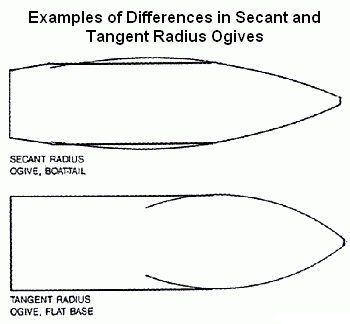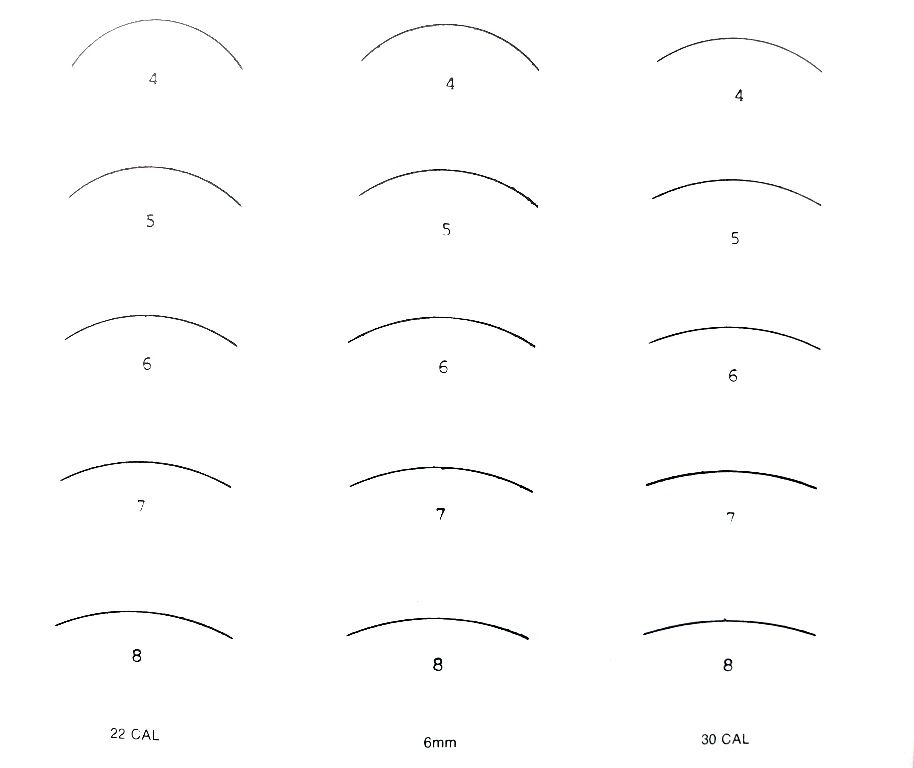Calculating Ogive
_______________________________
The 68 gr Ultras I’m shooting are flat base, dual radius bullets. They start 9 ogive in the rear and blend to 6.5 up front. Eventually I’ll discuss this design and others used in short-range BR. Until then I thought it would be interesting to show how ogives are derived.
Commercial bullet manufacturers publish ballistic coefficients and sectional densities (SD). Many benchrest brands are hand formed and vary in weight, curvature, and the tip diameter. We rarely cite BCs or SDs, instead focusing on jacket length, weight, base type, and ogive. The first three are readily apparent whereas the ogive isn’t.
Computing a bullet’s fundamental geometry:
1) Calculate the sectional density SD
SD = (Weight in grains) / (7000) * (diameter)^2
My Bart’s Ultras mic 0.2435” at the pressure ring
SD = (68) / (7000) * (0.2435)^2 = 0.1638
2) Calculating the ogive
L = length of the ogive nose from base to tip
D = diameter of the base of the ogive
T = diameter of the ogive tip
R = radius of the curve of the ogive in inches
To find the radius of the ogive:
R = Sqr(L) / (D – T) + (D – T) / 4
R1 = Sqr(L)
R2 = R1 / (D – T)
R = R2 + (D – T) / 4
To find the length of the ogive:
L = SqRt(R * (D - T) - Sqr(D - T) / 4)
L1 = Sqr(D - T)
L2 = L1 / 4
L3 = R * (D - T) - L2
L = SqRt(L3)
To find the diameter of the ogive tip:
T = D - 2 * R + SqRt(4 * (Sqr(R) - Sqr(L))
T1 = Sqr(R) - Sqr(L)
T2 = SqrRt(T1 * 4)
T = D - 2 * R + T2
To find the diameter of the ogive base
D = T + 2 * R - SqRt(4 * (Sqr(R) - Sqr(L))
D1 = Sqr(R) - Sqr(L)
D2 = SqrRt(D1 * 4)
D = T + 2 * R - D2
Ogive is the forward curved area between the bullet tip and base. That curve is the segment of a circle with radius “r”. Ogive simply denotes the number of calibers required to equal that “r” value. So a 7 ogive 6mm has a circular arc segment with r = 1.701” (7x 0.243”).

Ogive profiles are either tangent or secant.

* Tangent ogives – body of the bullet and ogive radius intersect at a single, tangent point
* Secant ogives – body of the bullet and ogive radius intersect at two points, neither of which are tangent to the base
Secant ogives impart less drag and offer higher BC’s. The trade-off is they’re more sensitive to seating depth. Many dual radius bullets, known as hybrids, use both tangent and secant curvatures. The tip which engages the rifling is tangent, the section between the shank and tip is secant.
If it weren’t for its double radius I’d show the calculation using a 68 gr Ultra. It gets messy though because even with an optical comparator it’s tough pinpointing the 9 to 6.5 transition. Instead I’ll share a chart guys used back in the single-ogive days:

You’ll see these are caliber specific and mimic the curvatures. By overlaying the bullet under magnification shooters found which ogive it best fit. This isn’t too scientific but does eliminate the need for involved math. Let’s test the chart with a single-radius design.
Berger, 52 gr Match Grade .22-caliber:

Using the above equations:
L = length of the ogive nose from base to tip = 0.476”
D = diameter of ogive base = 0.224”
T = diameter of the ogive tip = 0.057”
R = radius of the curve of the ogive in inches =

?
R = Sqr(L) / (D - T) + (D - T) / 4
R1 = Sqr(L) = 0.689
R2 = R1 / (D - T) = 1.319
R = R2 + (D - T) / 4 = 1.361
Ogive = R/D = 6.076
According to our calculations the Berger is a 6 ogive 22-cal. Overlaying it on the chart confirms this. Even if we didn’t have the chart we could make one. Merely take a compass, like the ones we had in elementary school, and set the radius to 1.361”. Then draw the arc. It’ll give you a twenty-two 6-ogive profile. Reversing these equations lets us create different ogives by caliber. Meaning we'd start with the known values of R, D, and the desired tip diameter. With 3 of the 4 inputs in hand we'd figure the length of the nose.
I realize this forum caters to the revolver crowd. But these principles absolutely apply to handgun bullets:

I’ve spent a lot of time studying these shapes, particularly the LBT series. Using rudimentary math, our optical comparator, and a micrometer, we can document (and duplicate) the precise geometry. When time permits I’ll do the analysis on bullets dropped from LBT molds (teaser – there’s nothing magical about their noses. They’re wonderful slugs but contain basic ogives, whether they be single or dual radius). More to come.
-Lee
www.singleactions.com"Chasing perfection five shots at a time"